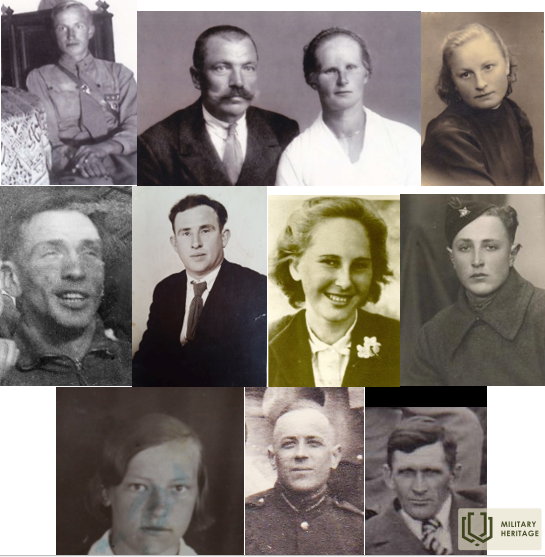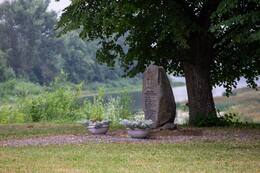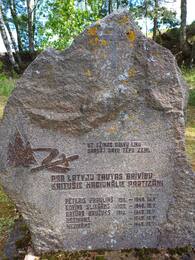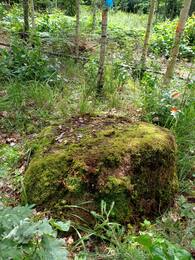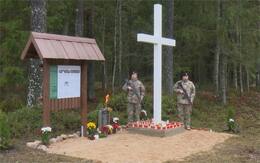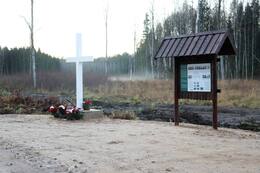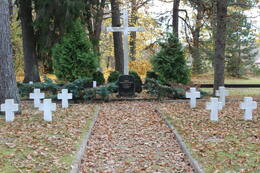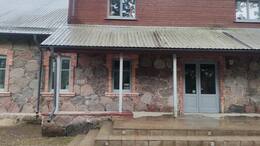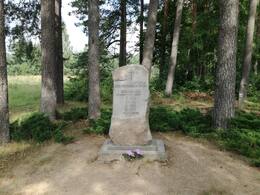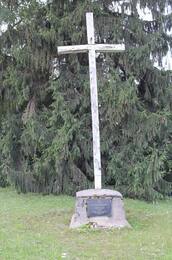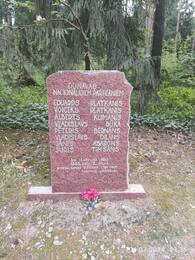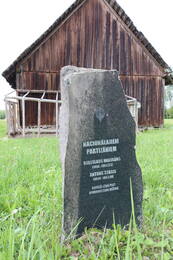Selio miško brolių gyvenvietė Sūpės pelkėje
Sūpės pelkė siejama su nacionalinių partizanų gyvenviečių ir mūšių vietomis, kurios susiformavo sąveikaujant žmonėms ir vietovėms. Ji aprašyta tremtinio latvių rašytojo Alberto Eglīčio baladėje apie įvykius jo gimtojoje Sūpės pelkėje „Samanose ir purve“ – duoklėje Sūpės pelkės partizanams:
... „1945 m., kai pelkėje švytėjo ruduo –
Pokļevinskio gimtadienio proga Lieljānis vakarienės metu dalijasi:
Gluosniuose fermentuotas alus,
Romulanai garbina sviestą,
Džiovinu mamos kmynų duoną,
Džiovintas kumpis kovo mėnesio gabalėliuose,
Ir Stučkos svogūnai,
Ildzeniecės sūris.
Kambariai dervingose sienose
Ir žaibas trenkė širdyse,
Ir vienuolikoje sielų merdi –
"Žemėje supuvusios šaknys..."
Ši praeities interpretacija su įvykiais po Antrojo pasaulinio karo apėmė žmonių liudijimus, dvasios išraiškas ir vertybių sistemas. Ji primena visuomenės paramą nacionaliniams partizanams, kurių okupacinė valdžia negalėjo taip lengvai nugalėti.
Po gyventojų deportacijų 1949 m. kovo 25 d. buvo sunaikinta nacionalinė partizanų aprūpinimo sistema. Nuo 1949 m. vasaros iki 1952 m. vidurio Sėlijos nacionalinis partizanų pasipriešinimo judėjimas Aknystės, Biržų, Elkšnų Gārsenės, Saukos, Susėjos ir Viesytės apylinkėse smuko. Pralaimėjimas įvyko dėl etninio valymo ir reguliarių armijos bei saugumo tarnybų veiksmų.
Indano-Gravelsono gyvenvietė su tokia rimta gynybos sistema šeštajame dešimtmetyje neegzistavo niekur kitur Latvijoje, įskaitant ir Sėlijos pietinę kaimynę Lietuvą. Indano-Gravelsono grupės bunkeris Elkšnų miške 1949–1950 m. žiemą pasižymi tuo metu unikalia gynybine tvirtove. Su specialiai sukurtais perimetro gynybos apkasais ir ginklų lizdais. Šeimos nariai negalėjo būti atskirti, o atsakomybę už jų saugumą pirmiausia prisiėmė vyrai, įgiję karinės patirties, taip pat pačios moterys, kurios nebijojo imtis ginklų. Jų tikslas pavojaus atveju buvo atremti užpuoliką. Ši ypatinga tapatybė, pasireiškusi paskutiniame karo etape, pasižymi represijų išvengusių šeimos narių įsitraukimu. Ji pasireiškė ir psichologiniu pasiruošimu, o mirtina baigtis nebebuvo netikėta. Indano-Gravelsono grupė gerai suprato savo beviltišką padėtį ir buvo pasirengusi kovoti iki mirties.
Indans-Gravelsons jungtinė nacionalinė partizanų grupė:
Grupės vadovas Jānis Indāns, Pēteris Indāns, Kristīne Indāne, Milda Ārija Indāne, Vasilijs Sokolovs, Jānis Ķepiņš, Hilda Vietniece, Artūrs Snikus, Alma Grāvelsone, grupės vadovas Jānis Edvards Grāvelsons, Jonas Žukauskas.
Žodinis parodymas
Partizanų ryšininkas Jānis Snikus : „Mārtiņš Pokļevinskis parodė bendrą partizanų kapą ir pasakė, kad ištraukė iš kapo mano brolį Artūrą Sniką, paguldęs jį galva į šiaurę. Mārtiņš Pokļevinskis tvirtino, kad partizanai per pigiai atidavė galvas, nes jiems tereikėjo palikti bunkerį sutemus, o tada prasiveržti. Ant bendro partizanų kapo buvo padėtas vainikas. Kartu su Mārtiniu Pokļevinskiu skubiai palaidojome miške nepalaidotą partizaną Voldemarą Sātniekštą, kiek įmanydamos iškasėme žemę.“
Vilma Birša (Saulītė): „1950 m. pavasarį, prieš užėmimą, su Mārtiniu Pokļevinskiu nuėjome apžiūrėti Indano-Grāvelsono bunkerio ir radome partizanų laidojimo vietą, kuri buvo netoli bunkerio. Pokļevinskis ilga lazda bandė apversti partizanus, kad būtų galima apžiūrėti, aiškiai mačiau Indaną, Sniką, Artūrą ir Mildinį, jie abu laikėsi vienas kito, Artūras vis dar turėjo žiedą ant rankos. Negalėjau ilgiau žiūrėti, nes viskas buvo nepakeliamai sunku. Vietoje, kur vyko mūšis, buvo mėtomos kareivių kepurės. Buvo matyti vietas, kur kariai buvo pasislėpę eglių šakomis ir laukė, kol partizanai paliks bunkerį.“
Jānis Plans: „Dirbau Viesytės geležinkelio stotyje traukinyje ir tą dieną turėjau važiuoti krauti medienos į 22-ąjį Elkšnių atšakos kilometrą. Kai atvykome į 14-ąjį kilometrą, mus sustabdė armijos įsakymas, nes prasidėjo šaudymas.“ Po šaudymo Janiui Plansui buvo duotas įsakymas: „ложись“ – atsigulti. Jānis Plans pakluso įsakymui ir atsigulė ant traukinio platformos. Kai traukinys pravažiavo šaudymo zoną, jis pamatė, kad už kiekvieno medžio miega baltai maskuojamaisiais drabužiais vilkintys kareiviai. Kai jis atvyko į 22-ąjį kilometrą, šaudymas atsinaujino dar intensyvesnis. „Kai pakrovėme medieną į traukinį ir grįžome atgal, šaudymas buvo liovęsis, bet visas miškas vis dar buvo apsuptas.“ Po šių įvykių vasaros mėnesį 14-ajame kilometre, kai jie kartu su mašinistu krovė medieną, Jānis Plans nuėjo apžiūrėti įvykio vietos. Priartėjęs prie bunkerio, jis pamatė nedidelį kalnelį, aplink kurį augo mažos eglės. Bunkeris su visais apkasais buvo išlikęs nepažeistas. Įėjęs į bunkerį, jis buvo tuščias, lubos nebuvo aukštos, bet jis galėjo išsitiesinti. Janis Plans prisimena, kad bunkerio viduje stovėjo stalas, o priešais įėjimą per du aukštus matėsi lava. Už 10–15 metrų nuo bunkerio buvo pirtis su akmeniniu židiniu.
Hilda Miezītė (vietniece): „Puolimas įvyko ryte, dar lengvai snigo. Tai buvo išdavystė ir tai buvo kažkoks miškininkas“. Hilda Miezītė prisiminė, kad aplinkui girdėjosi automobilių riaumojimas, atvyko pastiprinimas. Hilda nesupranta, kaip išliko gyva, nes kulkos liejosi iš visų pusių. Jos nuomone, bunkeris buvo apleistas, nes jie nebūtų galėję atsilaikyti, buvo mėtomos granatos ir kaukiama iš garsiakalbių. Gyvenvietė vienaip ar kitaip būtų sunaikinta. Gyvenant miško sąlygomis, niekam nebuvo leidžiama palikti gyvenvietės, vyravo griežta drausmė, egzistavo ir pravardės, kad nebūtų atskleista jų tapatybė. Vyrai reguliariai keitė sargybos postus. Bunkerio stogas buvo statomas ištisai iš rąstų, žemas su nedideliu pakilimu, padengtas žemėmis, velėna ir samanomis. Įėjimo pusėje buvo nedidelis pakilimas su nedideliu nuolydžiu į priešingą pusę. Dešinėje nuo įėjimo durų buvo įrengtas nedidelis langelis. Bunkeryje buvo lovos, o viduryje – krosnis. Daiktų ar namų apyvokos daiktų nebuvo daug – kai kurie teturėjo drabužius, kuriuos vilkėjo. Gyvenvietės kambariuose grojo patefonas su vinilo plokštelėmis, kurių jie kartkartėmis tyliai klausėsi.
Eglītis. Šaltojo sezono dainos: lyrinės žurnalistės pastabos. [Minneapolis: Sēļzemnieks, 1983, p. 28]
Susijusi laiko juosta
Susijusios temos
Susijusios vietos
Atminimo akmuo Rihardo Pārupo nacionalinei partizanų grupei
Įsikūręs Rygos gatvėje, netoli Krustpilio liuteronų bažnyčios.
1996 m. rugsėjo 22 d. Krustpilyje buvo atidengtas atminimo akmuo Rihardui Pārupui ir jo vadovaujamai nacionalinei partizanų grupei. Atminimo akmenį sukūrė skulptorius Ilgvaras Mozulānsas, o jo sukūrimą finansiškai parėmė Saeimos pirmininkė Ilga Kreituse. Šį renginį organizavo Latvijos nacionalinių partizanų asociacijos valdyba.
Rihardo Pārupo nacionaliniams partizanams,
kuriuos nužudė Čekos specialioji grupė
Richardas Parupsas (1914 m. – 1946 m. liepos 2 d.)
Grupės vadas
Richardas Stulpinsas (1923–1946 m. vasario 7 d.)
Alberts Avotiņš (1912 m. – 1946 m. liepos 2 d.)
Erikas Juhna (1928 m. – 1946 m. liepos 2 d.)
Aleksandrs Lācis (1919 m. – 1946 m. liepos 2 d.)
Petras Lokys (1921–1946 m. liepos 2 d.)
Jānis Ēvalds Zālītis (Āboliņš) (1911 – 1946 m., liepos 2 d.)
Zygfridas Bimšteinas, Teodoras Šmidtas (… – 1946 m. liepos 2 d.)
Uldis Šmits (... - 1946. 2. VII)
Peteris Lazdanas (1926–1947)
Erikas Konvalis (1929 – 1947. VI)
Niklāss Ošiņš (1908 m. – 1954 m. spalio 12 d.) – įvykdyta mirties bausmė Rygoje
Albertas Čiķauka (1911–1972 II) – kalėjo Mordovijos stovykloje
Rihardas Pārupsas gimė 1914 m. birželio 11 d. Krustpilio valsčiaus „Kaķīšiuose“. Antrojo pasaulinio karo metu jis buvo 15-osios Latvijos divizijos prieštankinės divizijos seržantas. Dalyvavo nacionalinėse partizanų operacijose Jekabpilio ir Maduonos apylinkėse, buvo Nacionalinio pasipriešinimo judėjimo narys, būrio Jekabpilio ir Maduonos apylinkėse vadas. Rihardas Pārupsas žuvo mūšyje su Čekos kariuomene 1946 m. liepos 2 d. Vietalvos valsčiuje. Deja, palaidojimo vieta nežinoma. Rygos brolių kapinėse įrengta atminimo lenta. 1945 m. rudenį Jekabpilio rajone buvo suformuota nacionalinė partizanų grupė, vadovaujama R. Pārupo. Per savo trumpą gyvavimo laikotarpį ji dalyvavo daugiau nei dvidešimtyje ginkluotų susirėmimų su tuometinės Vidaus reikalų ministerijos daliniais. Čekos pulkininko Kotovo ataskaitoje Rygos vadovybei teigiama, kad dėl grupės veiklos šiuo laikotarpiu sovietų valdžios veikla Jekabpilio ir Maduonos rajonuose buvo faktiškai paralyžiuota. R. Pārupo vadovaujami nacionaliniai partizanai rado ir sunaikino kelis tremtinių sąrašus, taip išgelbėdami daugelio žmonių gyvybes. Saugumo komiteto vadovybė, negalėdama sunaikinti nacionalinių partizanų būrio atviroje kovoje, į jį infiltravo keturis Čekos specialiosios grupės asmenis, kurie sušaudė dešimt būrio partizanų, tarp jų ir R. Pārupą. 1947 m. netoli Jaunkalsnavos buvo sušaudyti dar du, o 1951 m. – vienas šio būrio narys. Po dvidešimt penkerių metų sunkaus darbo Mordovijos lageryje keturioliktas R. Pārupo vadovaujamos grupės partizanas mirė likus kelioms dienoms iki išlaisvinimo.
P. Praulinio nacionalinio partizanų būrio narių atminimo vieta ir bunkerio vieta
Pēteris Prauliņš (1911–1949) Biržų parapijos nacionalinis partizanų būrelis priklausė Mārtiņa Pokļevinskio (1902–1951) vadovaujamai grupei. Grupė vykdė keletą partizaninių akcijų, kurių metu buvo baudžiami sovietų kolaborantai, rekvizuojamas okupacinės valdžios ekonominių įstaigų maistas ir turtas. P. Praulinio grupės partizanai nesilaikė pakankamo sąmokslo principo, daugelis asmenų lankydavosi jų gyvenvietėje, o tai sudarė sąlygas išdavystei. Karinės patirties stoka buvo vienas iš partizaninio ginkluoto judėjimo trūkumų.
P. Praulinio partizanų grupė Kalnos miške Biržų valsčiuje buvo sunaikinta 1949 m. gegužės 16 d. Latvijos SSR Valstybės saugumo ministerijos operacijos, kurioje dalyvavo ir kariniai daliniai, metu. Miško broliai buvo įsirengę gerai užmaskuotą bunkerį su perimetro gynyba, kuris buvo įsikūręs nenustatytame aukštyje pelkėtoje vietovėje. Partizanai mažiausiai 40 minučių įnirtingai priešinosi Čekos kariuomenei, tačiau krito visa grupė: Pēteris Prauliņš, Artūras Bružukas, Jānis Kalvāns, Edvīns Slikšāns ir Francis Skromanis. Sušaudyti miško broliai buvo numesti netoli valsčiaus namų, tačiau jų palaikai vėliau buvo palaidoti netoliese esančiuose žvyrduobėse. Sunkiai sužeista buvo Irma Bružuka, kuri buvo paimta į nelaisvę ir mirė gegužės 17 d. Jekabpilio ligoninėje. Ji buvo palaidota už kapinių ribų, tačiau, kai kapinės buvo išplėstos po Latvijos nepriklausomybės atkūrimo, ant jos kapo buvo pastatytas paminklas.
1998 m. lapkritį buvo pašventintas atminimo akmuo P. Praulinio grupės partizanams Kalnos valsčiuje. P. Praulinio bunkerio vieta yra Vidsalos 99-ojo kvartalo 4 sekcijoje, Kalnos valsčiuje. Akmuo, ant kurio sėdėjo P. Praulinis, yra išsaugotas.
P. Praulinio nacionalinės partizanų grupės bunkerio vieta
P. Praulinio bunkerio vieta yra Vidsalos kvartalo 99 4-oje dalyje, Kalnos valsčiuje. Akmuo, ant kurio sėdėjo P. Praulinis, yra išsaugotas.
P. Praulinio (1911–1949) partizanų grupė Kalnos miške Biržų valsčiuje buvo sunaikinta 1949 m. gegužės 16 d. Latvijos SSR Valstybės saugumo ministerijos operacijos, kurioje dalyvavo ir kariniai daliniai, metu. Miško broliai buvo įsirengę gerai užmaskuotą bunkerį su perimetro gynyba, kuris buvo įsikūręs nenustatytame aukštyje pelkėtoje vietovėje. Partizanai mažiausiai 40 minučių įnirtingai priešinosi Čekos kariuomenei, tačiau krito visa grupė: Pēteris Prauliņš, Artūras Bružukas, Jānis Kalvāns, Edvīns Slikšāns ir Francis Skromanis. Sušaudyti miško broliai buvo numesti netoli parapijos namų, tačiau jų palaikai vėliau buvo palaidoti netoliese esančiuose žvyrduobėse. Sunkiai sužeista buvo Irma Bružuka, kuri buvo paimta į nelaisvę ir mirė gegužės 17 d. Jekabpilio ligoninėje. Ji buvo palaidota už kapinių ribų, tačiau, kai kapinės buvo išplėstos po Latvijos nepriklausomybės atgavimo, ant jos kapo buvo pastatytas paminklas.
Biržų parapijos nacionalinis partizanų Peterio Praulinio būrelis priklausė Mārtiņa Pokļevinskio (1902–1951) vadovaujamai grupei. Ši grupė vykdė keletą partizaninių akcijų, kurių metu buvo baudžiami sovietų kolaborantai, rekvizuojamas okupacinės valdžios ekonominių įstaigų maistas ir turtas. P. Praulinio būrio partizanai nesilaikė pakankamos konspiracijos, daugelis asmenų lankydavosi jų gyvenvietėje, o tai sudarė sąlygas išdavystei. Karinės patirties stoka buvo vienas iš partizaninio ginkluoto judėjimo trūkumų.
Atminimo akmuo P. Praulinio grupės partizanams Kalnos parapijoje buvo pašventintas 1998 m. lapkritį.
J. Indānso, J. Grāvelsono ir M. Pokļevinskio nacionalinių partizanų grupių narių atminimo vieta
Lačplėsio dieną – 2019 m. lapkričio 11 d. – buvo atidarytas Indano-Grāvelsono nacionalinių partizanų grupės informacinis stendas ir atminimo vieta Kalnos valsčiuje, Jekabpilio rajone, Sūpės purvo apylinkėse. Jo atidaryme dalyvavo Jekabpilio ir Viesytės regionų atstovai, buvęs nacionalinis partizanas H. Miezīte, istorikas H. Bruņinieks, taip pat svečiai iš Lietuvos ir kiti susidomėję asmenys. Atminimo vieta ir stendas yra netoli Sūpės purvo, kuris siejamas su nacionalinių partizanų gyvenviečių ir mūšių vietomis. Giliau miške taip pat buvo Indano-Grāvelsono grupės bunkeris.
Po Latvijos gyventojų deportacijų 1949 m. kovo 25 d. buvo sunaikinta nacionalinių partizanų aprūpinimo sistema. Nuo 1949 m. vasaros iki 1952 m. vidurio nacionalinis partizanų judėjimas Aknystės, Saukos, Elkšnių, Biržų ir Viesytės apylinkėse išgyveno nuosmukį, nes kentėjo nuo etninio valymo ir reguliarių sovietų armijos bei saugumo institucijų kontrpuolimų. Janio Indano ir Janio Grāvelsono nacionalinių partizanų grupės įsikūrimas Elkšnių miške 1949–1950 m. žiemą turėjo labai rimtą, tuo metu nebūdingą gynybos sistemą, kurios 1950-aisiais nebuvo niekur kitur Latvijoje ar kaimyninėje šalyje Lietuvoje. Indano-Grāvelsono grupės bunkeryje buvo specialiai sukurti perimetro gynybos apkasai ir patrankų lizdai. Greta partizanų karinio pasirengimo paaukoti savo gyvybes kovoje su priešu, galima kalbėti ir apie jų ypatingą tapatybę, kuri pasireiškė ir kitų šeimos narių įsitraukimu į nacionalinių partizanų gretas.
Jungtinę Indano-Grāvelsonų partizanų grupę sudarė 12 žmonių, tarp kurių buvo penkios moterys ir vienas Lietuvos partizanas: Jānis Indāns, Jānis Edvards Grāvelsons, Alma Grāvelsone, Pēteris Indāns, Kristīne Indāne, Milda Ārija Indāne, Vasilijs Sokolovs, Voldemārs Otto Sātnieks, Jonda Sātnieks, Jānis Ķepiņš. Žukauskis. Paskutinis jų mūšis įvyko 1950 metų vasario 25 dieną Elkšnių girioje, kai mūšyje su neproporcingai stipriomis jėgomis krito 11 partizanų. Išgyveno tik Hilda Vietniece (Miezīte), kuri buvo sugauta ir vėliau šešerius metus praleido kalėjime Gulago lageriuose.
Atminimo vieta 1945 m. vasario 13 d. nacionalinių partizanų mūšio vietoje Kalnos parapijos Deimantų miške
Memorialinė vieta buvo sukurta rajoniniame kelyje P74 Siliņi – Aknīste, 12 kilometrų nuo Aknīstės, pasukus į Latvijos valstybinį mišką „Žagari kelias“.
Jau 1944 m. vasaros pabaigoje didžiulis Elkškių valsčiaus šiaurinės dalies miškų masyvas tapo žmonių, besiruošiančių ginkluotai kovai su sovietų okupacine valdžia, susibūrimo vieta. 1944 m. pabaigoje Aknystės apylinkėse pradėjo kurtis nacionalinių partizanų grupės. Tinkama vieta partizanų stovyklai įkurti buvo Deimantinis miškas , esantis Elkškių didžiojo miško pietiniame pakraštyje, netoli Aknystės Didžiosios pelkės. Ten, mažiau nei 10 kilometrų nuo Aknystės valsčiaus, nacionaliniai partizanai įrengė tris žiemos bunkerius žiemojimui. Miške susirinkusių vyrų susisiekimas buvo užtikrinamas padedant netoliese esančių namų – Baltimorės, Gargrodžių, Lyčių, Priedžių, Krūmų – ir kitų namų gyventojams, kaimynams bei partizanams.
Partizanų mūšis su Latvijos SSR Valstybės saugumo ministerijos kareiviais Deimantų miške įvyko 1945 m. vasario 13 d. Čekistai, paėmę įkaitus, juos nustūmė į priekį, kad atidengtų partizanų bunkerius. Miško broliai, pamatę pavojų, atidengė ugnį, negailėdami įkaitų. Mūšyje žuvo 10 sovietų okupacinių kariuomenės atstovų, aštuoni nacionaliniai partizanai ir keturi įkaitai. Nepaisant miško brolių nuostolių, čekistams nepavyko užimti partizanų bunkerių. Išlikę partizanai palaukė sutemų ir paliko gyvenvietę. Mūšyje sužeisti čekistų kareiviai, dejuodami, negalėjo palikti mūšio lauko. Po šio mūšio, kurį galima laikyti pirmuoju miško brolių „kovos krikštu“, partizanai jautėsi kaip broliai, o šautuvas atrodė brangesnis už viską, kaip vienintelis patikimas gelbėtojas.
Baltasis kryžius ir informacinis stendas Deimantų miške buvo įrengti Lačplėsio dieną – 2022 m. lapkričio 11 d. Atminimo vietos sukūrimą parėmė Jekabpilio regioninė valdžia, asociacija „Tēvzemes sargi“ ir Latvijos valstybiniai miškai. Informacinio stendo turinio autorius yra istorikas Haraldas Bruņinieksas.
Sėlijos nacionalinių partizanų brolių kapinės
Sėlijos nacionalinių partizanų brolių kapinės buvo atidarytos 2004 m. spalio 30 d., remiant Latvijos gynybos ministerijai ir Aknīstės savivaldybei. Jose palaidoti 1949 m. gruodžio 19 d. mūšyje Kalnos parapijos Dimantų miške žuvę partizanai: Albertas Karankevičius (1914–1949), Vilis Tunkelsas (1911–1949), Arnoldas Tunkelsas (1926–1949), Osvaldas Tunkelsas (1929–1949), Ēvaldas Kundzanas (1927–1949).
2005 m. čia buvo perlaidoti ir 1945 m. vasario 13 d. mūšyje Elkšnių girioje kritę partizanai: Juris Alfreds Voldemārs Lācis (1908-1945), Eduards Kaminskis (1910-1945), Albertas Mežaraups (1945 m. Alberts Mežaraups, 1945 m. (1915-1945), Antons Bružiks (1911-1945), Jānis Britāns (1926-1945) ir vienas nežinomas. Bendrosiose kapinėse taip pat yra sovietų okupacinės valdžios įkaitais paimtų ir mūšio metu žuvusių Martos Mežaraupės (1907–1945), Alberto Lācio (1902–1945), Jurio Resnīčio (1901–1945) ir Pēterio Bitės (1907–1945) palaikai, taip pat žuvusio Indano-Grāvelsono grupės partizano Voldemaro Otto Sātniekas (1911–1950). Aknīstės brolių kapinėse taip pat yra paminklas Aknīstės kuopos nacionaliniam partizanui Alfredui Silaraupui (1925–1946), žuvusiam per Čekos operaciją 1946 m. liepos 30 d. siaurajame geležinkelyje Elkšnių miške.
Sėlijos nacionalinių partizanų brolių kapinėse pastatyto Baltojo kryžiaus papėdėje stovi juodo granito stela su Latvijos nacionalinių partizanų asociacijos emblema ir po ja iškaltu tekstu „Sėlijos nacionaliniams partizanams. Jūs paaukojote savo gyvybes už Latviją kovoje su komunistiniu okupaciniu režimu 1944–1954 m.“ Kapinėse taip pat yra paminklinis akmuo su užrašu „Yra ašarų, kurios bus išlietos tyloje. Yra randų, kurie neužgis užgijus“, kurį Stanislava Šadurska pastatė Atgimimo pradžioje netoli duobės, kurioje čekistai palaidojo dieną prieš tai, 1955 m. vasario 14 d., žuvusius nacionalinius partizanus ir įkaitus.
Buvę Susėjos parapijos namai, nacionalinių partizanų išpuolio vieta 1945 m. liepos 7 d.
Šiandien buvusiuose Susėjos parapijos namuose įsikūręs Sanssouci rezidencijų centras. Pastato fasade vis dar matyti nacionalinių partizanų kulkų palikti pėdsakai 1945 m. liepos 7 d. puolimo metu.
Buvę Susėjos parapijos namai, tuo metu veikę kaip sovietų okupacinės valdžios vietinis vykdomasis komitetas, 1945 m. liepos 7 d. nukentėjo nuo Sėlijos nacionalinių partizanų išpuolio. Išpuolis prieš Susėjos vykdomąjį komitetą buvo platesnės nacionalinių partizanų kampanijos dalis ir vyko tuo pačiu metu kaip ir išpuoliai prieš Vilkupės sviesto fabriką bei naikintojo Kaunacko namą.
Susėjos nacionalinių partizanų grupės vado Alberto Kaminskio (1920–1946) nurodymu miško broliai turėjo sunaikinti vietos vykdomojo komiteto apsaugą, paimti ginklus, milicijos uniformas, dokumentus ir sugadinti telefono ryšį. Susėjos vykdomojo komiteto puolime dalyvavo apie 17 miško brolių, vadovaujamų Lietuvos partizanų vado Jozo Kuveikio. Mūšis truko 15–20 minučių, susišaudymo metu žuvo vienas Lietuvos partizanas, o kitoje pusėje – naikintojų bataliono Jānio Kakarano kovotojas. Susišaudymo metu buvo išdaužti vykdomojo komiteto langai ir apgadintas telefonas.
Antrasis išpuolis prieš Susėjos vykdomąjį komitetą įvyko 1945 m. liepos 16 d., kai vyko užsitęsęs susišaudymas tarp „Miško brolių“ ir naikintojų bataliono kovotojų, kurie buvo pasislėpę Vykdomojo komiteto pastate. Mūšio metu pastariesiems į pagalbą atėjo grupė sovietų kareivių, kurie iš flango atidengė kulkosvaidžių ugnį ir privertė partizanus trauktis. Mūšyje žuvo mažiausiai penki „Miško broliai“ ir penki naikintuvai. Išpuoliai prieš šį okupacinės valdžios administracinį objektą patvirtino partizaninio karo ginkluoto pasipriešinimo pobūdį ir buvo įspėjimas apie žmonių pasipriešinimą sovietų okupacinei valdžiai.
Susėjos nacionalinių partizanų paminklas
Susėjos nacionalinis partizanų būrys buvo suformuotas iš mažesnių suskaidytų miško brolijos grupių, nes iš pradžių nebuvo vadovo, kuris galėtų jas suvienyti. Trumpą laiką Artūras Grābeklis bandė koordinuoti Susėjos partizanų, o vėliau ir Markejaus Gorovniovo, žuvusio 1945 m. žiemą, veiklą. Susėjos nacionalinis partizanų būrys buvo sustiprintas po to, kai po visuotinės Vokietijos kapituliacijos į Kuršą, Sėliją, atvyko buvęs legionierius Albertas Kaminskis. Jis įvedė griežtesnę drausmę ir suvienijo mažesnes grupes bendrai kovai su sovietų okupacine valdžia. Taip pat buvo bendradarbiaujama su miško brolijos grupėmis iš netoliese esančių parapijų ir vietovių, ypač su Gārsenės grupe ir Lietuvos partizanais, kurie buvo įsikūrę Lietuvos ir Latvijos pasienyje.
Ankstyvaisiais ginkluoto judėjimo etapais akivaizdu, kad miško broliai nebuvo pasiruošę puolimams, negalėjo užimti nei Kaunackų sodybos, nei įsilaužti į Susėjos vykdomojo komiteto pastatą. Partizanai patyrė nuostolių ir ilgai negalėjo pasipriešinti Čekos kariuomenei, o pagrindinis kovos metodas buvo galvoti apie atsitraukimą laiku. Taip pat buvo problemų dėl partizanų aprūpinimo. Nepaisant esamų sunkumų, Susėjos nacionalinis partizanų būrys pirmaisiais pokario metais vis dar sugebėjo aktyviai priešintis sovietų okupacinei valdžiai. Ši partizanų grupė nustojo egzistavusi po jos vado A. Kaminskio žlugimo 1946 m. gegužės 14 d. Po to sekė ir kelių miško brolių legalizavimas, taip pat prisijungimas prie kitų partizanų grupių.
Paminklas Susėjos kuopos nacionaliniams partizanams atidengtas 1997 m. lapkričio 11 d. Sėlijos nacionalinių partizanų istorijos tyrinėtojo Gunāro Blūzmo iniciatyva. Šalia žuvusių Susėjos nacionalinių partizanų vardų, grubiai apdirbtame riedulyje po kryžiaus ženklu iškaltas tekstas: „Ant ežio galvos įsakiau tau saugoti tėvo žemę“. Paminkle minimi 1945 m. liepos 16 d. užpuolus Susėjos vykdomąjį komitetą žuvusieji – Jānis Grābeklis (1923-1945), Ādolfas Rācenis (1919-1945), Broņislavs-Arvīds Bīriņš (1919-1945), vėlesnis vardas9 (Edgars450-1) ir Edgars45. buvo pridėti nužudytieji Lina Kaminska (1917-1945) ir Albertas Kaminskas (1920-1946). Ant paminklo trūksta Arnoldo Dombrovskio (1923-1945) ir kitų Susėjos tautinių partizanų grupėse veikusių, 1945-1946 metais kritusių nacionalinių partizanų pavardžių.
Latvijos ir Lietuvos nacionaliniams partizanams atminti skirtas memorialas Slate.
Baltas kryžius su stela Slate nacionaliniams partizanams Rubenės parapijoje buvo pašventintas 2002 m. spalio 25 d.
Tai buvo jungtinė latvių ir lietuvių grupė, vadovaujama Jāzepo Fričo (1920–1947). Grupei taip pat priklausė Lietuvos partizanų vadas Jozas Streikus (1923–1962), Jānis Ruzga (1924–1948) ir kiti nacionaliniai partizanai, aktyviai priešinęsi sovietų okupaciniam režimui Slateso ir aplinkinėse parapijose.
Memorialas 1945 m. liepos 2 d. vykusių nacionalinių partizanų mūšio prie Dunojaus vietoje
Atminimo akmuo 1945 m. liepos 2 d. Dunojaus mūšyje žuvusiems nacionaliniams partizanams Jāniui Abaronui, Vladislavui Būkui, Pēteriui Bernanui, Albertui Klimaniui, Vladislavui Dilanui ir Juriui Timšānui, vėliau sudegusiems Rubenės valsčiuje.
Dunavos mūšis kilo po to, kai birželio 30 ir liepos 1 d. vakare Ataugoje, Dunavos valsčiuje, per miškininkų ir sovietų okupacinės valdžios atstovų susidūrimus žuvo du Latvijos SSR Vidaus reikalų liaudies komisariato pareigūnai ir vienas milicininkas. Liepos 2 d. 16 tautinių partizanų, vadovaujamų Eduardo Platkanio, Rubenės kelio posūkyje už Dunavos kapinių kovėsi mūšyje su naikintojais, milicininkais ir Čekos kariais. Po kelių dienų, keršydami, Čekos pareigūnai sudegino Ataugos namus, o prie Rubenės valsčiaus salės viešai sudegino šešių tautinių partizanų, žuvusių Dunavos mūšyje, kūnus.
Paminklas nacionaliniams partizanams B. Mikulašui ir A. Stariui
Paminklas nacionaliniams partizanams Boleslavui Mikulanui (1918–1951) ir Antonui Stariui (1909–1953) iš Latvijos Tėvynės sargybos (partizanų) asociacijos Ilūkstės partizanų pulko buvo atidengtas 2003 m. lapkričio 1 d. „Kuršu“ ūkyje Celminiekiuose, Dunavos valsčiuje, Sėlijos nacionalinių partizanų tyrinėtojo Gunāro Blūzmos iniciatyva.
Nuo 1944 m. rugpjūčio mėn. B. Mikulanas aktyviai veikė įvairiose nacionalinių partizanų grupėse, įskaitant Bebrenės kuopą ir Dignajos grupę 1949 m. 1949/1950 m. B. Mikulanas kartu su A. Stari slapstėsi pas Janį Brakovką Kuršių nerijoje, didelio Bebrenės Celminieki miško pakraštyje. Kai 1951 m. gegužės 9 d. B. Mikulanas vyko pasiimti produktų, jį nužudė Švarojus, Čekos 2-ojo N dalinio karininkas. A. Stari nusižudė 1953 m. kovo mėn., kai Kuršių neriją apsupo Čekos karininkai.
Ant memorialinės stelos iš granito, šalia žuvusių nacionalinių partizanų B. Mikulano ir A. Staro vardų, iškaltas užrašas: „Žuvę kovoje su komunistiniu režimu“.
Pormalių brolių partizanų grupės „Vilkaci“ atminimo vieta
Nacionalinis partizaninis karas, Latvijoje tęsęsis iki šeštojo dešimtmečio vidurio, neaplenkė ir Sėlijos regiono, kur nuo 1944 m. rudens Seceso ir Sėlpilio valsčiuose aktyviai veikė brolių Pormalių partizanų grupė „Vilkaci“.
Pormalių brolių nacionalinio partizano grupė susikūrė 1944 m. rudenį, kai Paulis ir Jānis Pormaliai, kaip Vokietijos armijos kontržvalgybos grupės „Zeppelin“ dalis, perėjo fronto liniją netoli Koknesės ir perplaukė Dauguvą, grįždami į gimtąją Secės valsčių, Jėkabpilio rajoną.
1945 m. vasarį partizanai sutrukdė suimti dvarininką Kliavinskį, užpuolę čekistų grupę prie Vīgantės mokyklos, sugavo ir nuteisė mirties bausme Seceso autotechnikos stoties direktorių Kārlį Taurinį, kuris aktyviai dalyvavo 1941 m. birželio 14 d. trėmimuose, o grįžęs iš Rusijos vėl grasino latviams deportacija į Sibirą.
1945 m. vasarą partizanai taip pat atsisuko prieš sovietų organizuotą Sečės miškų kirtimą, ne kartą šaudydami į miško darbams paskirtus ginkluotus darbininkus, kuriems vadovavo vietos komunistų partijos organizatorius Turčinas. Taip pat buvo plačiai daroma žala geležinkelio bėgiams ir žemės ūkio technikai, sabotuojama kūlimas. Per nacionalines šventes partizanai aukščiausiose vietose iškabindavo savarankiškai pagamintas Latvijos vėliavas.
Pormalių brolių partizanų grupė miške taip pat išleido kelis nelegalaus laikraščio „Vilkaču Sauciens“ numerius.
Sovietų saugumo institucijos netgi buvo paskelbusios 10 tūkstančių rublių atlygį už Pormalų brolių pasidavimą.
1946 m. rugpjūčio 11 d. dėl išdavystės čekistai apsupo Pormalių brolius vietos miškininko namuose. Paulis išėjo iš namų pro galines duris, bet Janis sugebėjo pabėgti bėgdamas per rugių lauką į mišką.
1946 m. spalio 16 d. čekistams pavyko įvilioti į spąstus partizanų grupės vadą Paulių Pormali, kuris pateko netoli „Taiminių“ namų Secės valsčiuje.
1948 m. rugpjūčio 8 d. Baltijos karo apygardos karinis tribunolas nuteisė Jānį Pormāli kalėti dvidešimt penkerius metus. Aštuoniolika ilgų metų jis praleido sovietų vergų stovyklose Vorkutoje, Taišete ir Mordovijoje, o į Latviją grįžti galėjo tik 1965 m.





